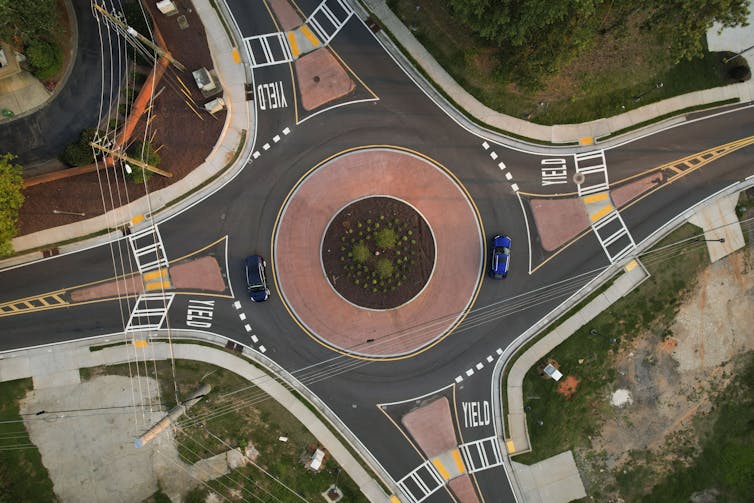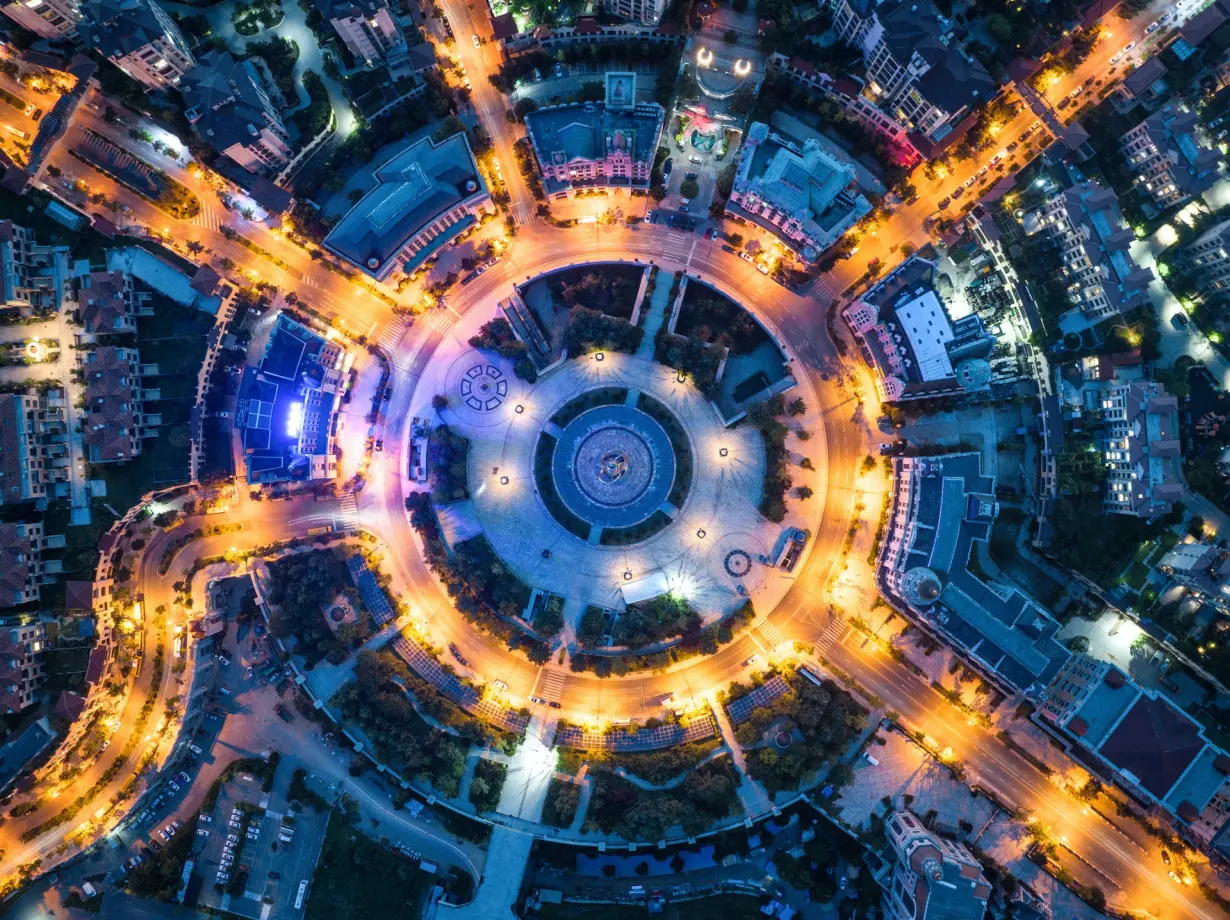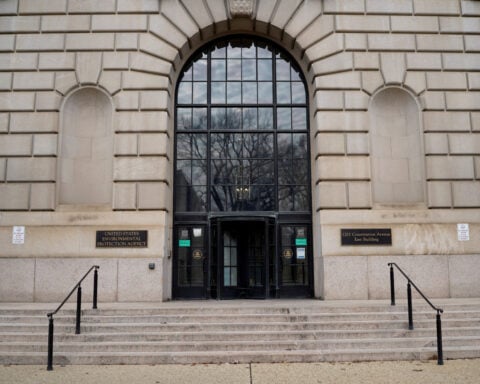If you live on the East Coast, you may have driven through roundabouts in your neighborhood countless times. Or maybe, if you’re in some parts farther west, you’ve never encountered one of these intersections. But roundabouts, while a relatively new traffic control measure, are catching on across the United States.
Roundabouts, also known as traffic circles or rotaries, are circular intersections designed to improve traffic flow and safety. They offer several advantages over conventional intersections controlled by traffic signals or stop signs, but by far the most important one is safety.

Modern roundabouts can have one or two lanes, and usually have four exit options.
I research transportation engineering, particularly traffic safety and traffic operations. Some of my past studies have examined the safety and operational effects of installing roundabouts at an intersection. I’ve also compared the performance of roundabouts versus stop-controlled intersections.
A brief history of roundabouts
As early as the 1700s, some city planners proposed and even constructed circular places, sites where roads converged, like the Circus in Bath, England, and the Place Charles de Gaulle in France. In the U.S., architect Pierre L'Enfant built several into his design for Washington, D.C.. These circles were the predecessors to roundabouts.
In 1903, French architect and influential urban planner Eugène Hénard was one of the first people who introduced the idea of moving traffic in a circle to control busy intersections in Paris.
Around the same time, William Phelps Eno, an American businessman known as the father of traffic safety and control, also proposed roundabouts to alleviate traffic congestion in New York City.
In the years that followed, a few other cities tried out a roundabout-like design, with varying levels of success. These roundabouts didn’t have any sort of standardized design guidelines, and most of them were too large to be effective and efficient, as vehicles would enter at higher speeds without always yielding.
The birth of the modern roundabout came with yield-at-entry regulations, adopted in some towns in Great Britain in the 1950s. With yield-at-entry regulations, the vehicles entering the roundabout had to give way to vehicles already circulating in the roundabout. This was made a rule nationwide in the United Kingdom in 1966, then in France in 1983.
Yield-at-entry meant vehicles drove through these modern roundabouts more slowly, and over the years, engineers began adding more features that made them look closer to how roundabouts do now. Many added pedestrian crossings and splitter islands – or raised curbs where vehicles entered and exited – which controlled the vehicles’ speeds.
Engineers, planners and decision-makers worldwide noticed that these roundabouts improved traffic flow, reduced congestion and improved safety at intersections. Roundabouts then spread throughout Europe and Australia.
Three decades later, modern roundabouts came to North America. The first modern roundabout in the U.S. was built in Summerlin, on the west side of Las Vegas, in 1990.
Roundabouts require the driver to yield before entering and signal before exiting.
Ever since, the construction of modern roundabouts in the U.S. has picked up steam. There are now about 10,000 roundabouts in the country.
Why use roundabouts?
Roundabouts likely caught on so quickly because they reduce the number of potential conflict points. A conflict point at an intersection is a location where the paths of two or more vehicles or road users cross or have the potential to cross. The more conflict points, the more likely vehicles are to crash.
A roundabout has only eight potential conflict points, compared to 32 at a conventional four-way intersection. At roundabouts, vehicles don’t cross each other at a right angle, and there are fewer points where vehicles merge or diverge into or away from each other.
The roundabout’s tight circle forces approaching traffic to slow down and yield to circulating traffic, and then move smoothly around the central island. As a result, roundabouts have fewer stop-and-go issues, which reduces fuel consumption and vehicle emissions and allows drivers to perform U-turns more easily. Since traffic flows continuously at lower speeds in a roundabout, this continuous flow minimizes the need for vehicles to stop, which reduces congestion.
The Federal Highway Administration estimates that when a roundabout replaces a stop sign-controlled intersection, it reduces serious and fatal injury crashes by 90%, and when it replaces an intersection with a traffic light, it reduces serious and fatal injury crashes by nearly 80%.
Why do some places have more than others?
Engineers and planners traditionally have installed roundabouts in intersections with severe congestion or a history of accidents. But, with public support and funding, they can get installed anywhere.
For some traffic engineers, the sky’s the limit.
But roundabouts aren’t needed in every intersection. In places where congestion isn’t an issue, city planners tend not to push for them. For example, while there are around 750 roundabouts in Florida, there are fewer than 50 in North Dakota, South Dakota and Wyoming combined.
Roundabouts have been gaining popularity in the U.S. in recent years, in part because the Federal Highway Administration recommends them as the safest option. Some states, like New York and Virginia, have adopted a “roundabout first” policy, where engineers default to using roundabouts where feasible when building or upgrading intersections.
In 2000, the U.S. only had 356 roundabouts. Over the past two decades, that number has grown to over 10,000. Love them or hate them, the roundabout’s widespread adoption suggests that these circular intersections are here to stay.

Deogratias Eustace receives funding from research funding agencies.
Source: The Conversation

 Trump has begun another trade war. Here's a timeline of how we got here
Trump has begun another trade war. Here's a timeline of how we got here
 Canada's leader laments lost friendship with US in town that sheltered stranded Americans after 9/11
Canada's leader laments lost friendship with US in town that sheltered stranded Americans after 9/11
 Chinese EV giant BYD's fourth-quarter profit leaps 73%
Chinese EV giant BYD's fourth-quarter profit leaps 73%
 You're an American in another land? Prepare to talk about the why and how of Trump 2.0
You're an American in another land? Prepare to talk about the why and how of Trump 2.0
 Chalk talk: Star power, top teams and No. 5 seeds headline the women's March Madness Sweet 16
Chalk talk: Star power, top teams and No. 5 seeds headline the women's March Madness Sweet 16
 Purdue returns to Sweet 16 with 76-62 win over McNeese in March Madness
Purdue returns to Sweet 16 with 76-62 win over McNeese in March Madness








